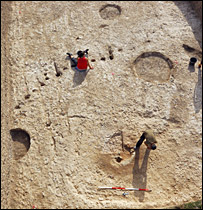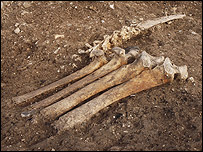Find the home of the man who built Stonehenge

This area was once home to hundreds of people (photo: BBC)
In Durrington Walls excavation area, near the legendary Salisbury Plain monument, traces of ancient houses have been found. It seems that people at that time used this place seasonally to organize sacrifices and burials.
In ancient times, the camp was probably home to several hundred people, and probably the largest Neolithic population ever discovered in England. This relic was dated between 2,600 and 2,500 BC, the same time Stonehenge was built.
Archaeologist Mike Parker Pearson from the University of Sheffield said: 'In the ruins of the houses, we found traces of box beds and wooden cabinets.' He said the monuments are identical to the Neolithic houses at Skara Brae - a fairly intact relic thanks to being made of stone.
Researchers have excavated a total of eight houses in the Durrington camp. In addition, thanks to geophysical survey equipment, they discovered some other relics.
Archaeologists believe that there must be at least one hundred old houses here. According to Professor Parker Pearson, each house is only about 5 square meters wide. The houses are made of wood, with clay floors and a pillar in the middle. Archaeologists also found 4,600-year-old rubber pieces covering the floor.

People found animal bones in old houses (photo: BBC)
Professor Parker Pearson told the BBC: 'This is the richest relic of the Neolithic period that people have ever known in the UK.' 'We have never seen so much pottery, animal bones and flint. '.
Researchers at Shefield University believe that the ancient people did not live in the camp for the whole year. He argued that the Stonehenge and Durrington areas were a religious population used in burial ceremonies.
Professor Pearson also said that this is the place where the Neolithic residents of the area gather. They came to gather together in the middle of the winter to eat, party, and even throw bones on the floor.
He said: "There are lots of bad animal bones being thrown away. We call this event a banquet party - and perhaps this is where the first parties were in history."

Famous stone stonehenge of England (Photo: BBC)
- Archaeologists found evidence of the people who built the ancient Stonehenge
- Solution to the mysteries of ancient stone beach Stonehenge
- Find the origin of the blue rocks at Stonehenge?
- Pythagoras may not be the first to apply his theorem
- 'Blue Stonehenge' - discovery from British archaeologists
- The stone piece from the wonders of Stonehenge is returned after 60 years
- Materials to help the ancient people transport tons of stone built Stonehenge
- New theory about the formation of Stonehenge
- Discovering more mysteries in ancient stone dumps Stonehenge 5,000 years in England
- Stonehenge's ancient stone beach can be born in Wales
- Rewrite history Stonehenge
- Stonehenge of Australia - great mystery without a solution
 Discovered an ancient centipede fossil 99 million years old
Discovered an ancient centipede fossil 99 million years old Discovered bat-like dinosaurs in China
Discovered bat-like dinosaurs in China Discovered a 200-year-old bronze cannon of the coast
Discovered a 200-year-old bronze cannon of the coast Discover 305 million-year-old spider fossils
Discover 305 million-year-old spider fossils Why are 76% of rich people introverts?
Why are 76% of rich people introverts?  13 extremely popular questions about the world that everyone is confident they know everything about, but are actually completely wrong.
13 extremely popular questions about the world that everyone is confident they know everything about, but are actually completely wrong.  Extremely interesting facts about the legend of bo bo during the subsidy period
Extremely interesting facts about the legend of bo bo during the subsidy period  Before and now photos show how women of all ethnicities around the world have changed over the past 100 years
Before and now photos show how women of all ethnicities around the world have changed over the past 100 years  These photos show how much the world has changed in just a few years.
These photos show how much the world has changed in just a few years.  Top 10 unique things that only exist in some countries in the world, seemingly normal but extremely interesting
Top 10 unique things that only exist in some countries in the world, seemingly normal but extremely interesting 